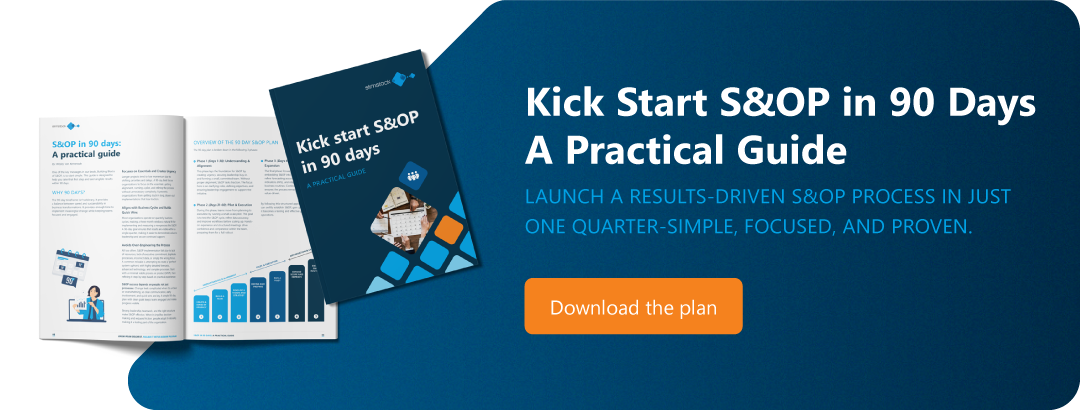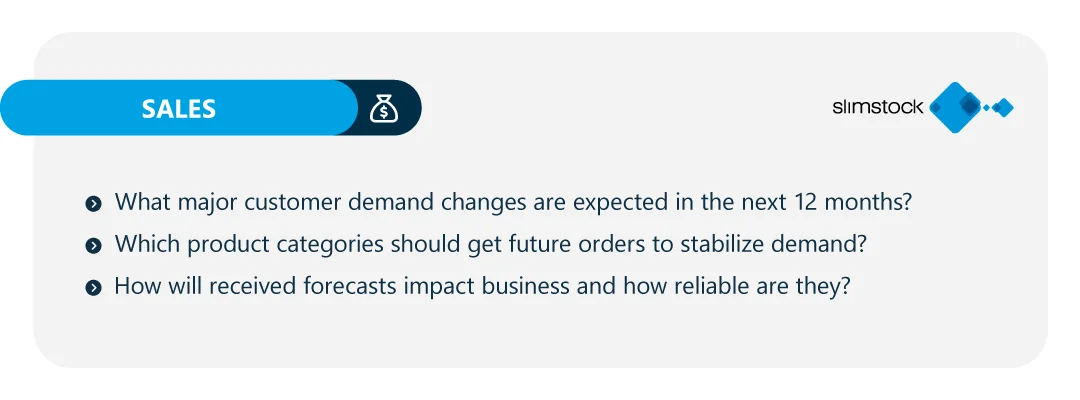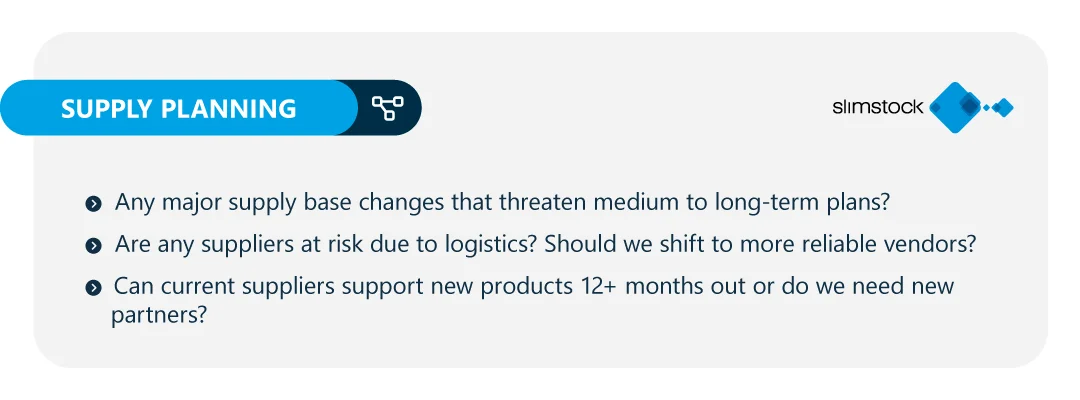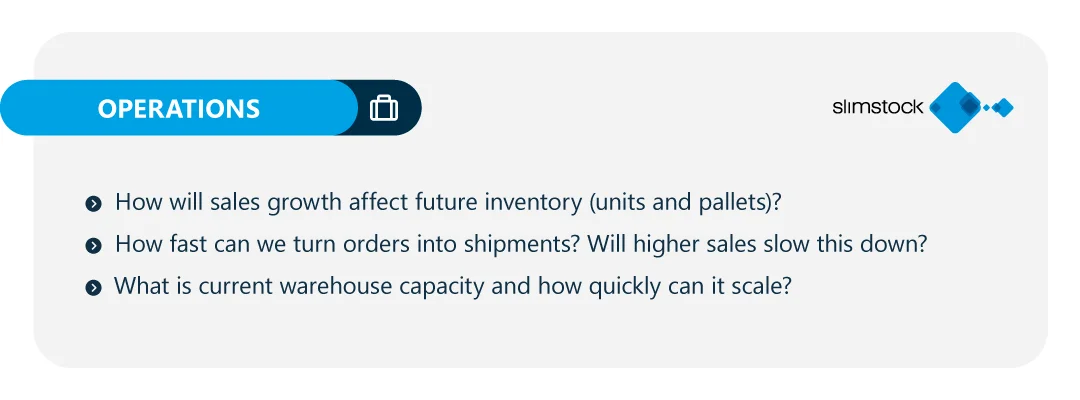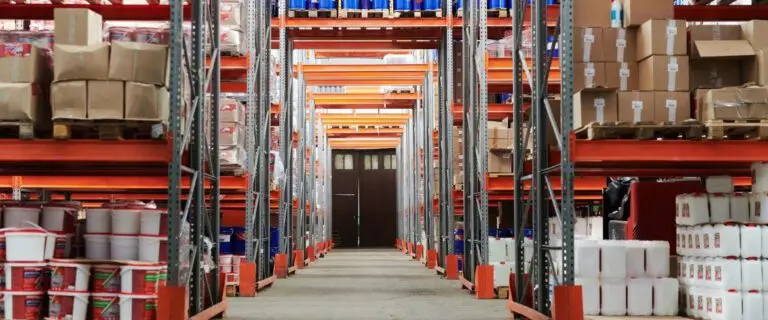Accurate and timely data can be the life blood that feeds your Sales and Operations Planning process. Ensuring your supply chain, sales, and operations teams have the data they need, when they need it, and in a standardised and clear format, will enable the communication that is needed to drive a transformational Sales and Operations Planning process.
The process of identifying data requirements for S&OP involves determining the types of data needed to support the planning and decision-making process. A great first step is to ensure the Sales and Operations Planning leadership is aligned with the overarching goals of the S&OP process, as the data required will tie directly to what should be measured and improved upon.
We can start by clarifying the specific goals and objectives of the S&OP process. This could include optimizing inventory levels, improving forecast accuracy, aligning supply with demand, improving customer service levels, or enhancing overall operational efficiency and resource utilisation.
If the leadership team owning the S&OP process is not aligned then there is no one connecting the dots at the highest level nor painting a clear picture for the organisation of why you are collaborating, driving improvements, and future proofing your business in the first place. While this may seem like a step backwards, taking a moment to articulate the strategic vision and how that translates into various goals with multiple departments, and get their buy in is what S&OP is all about. The ability to execute on that vision will rely on the collaboration between:
- The sales team, what sales growth is planned and through what channels.
- The supply chain team, how can our supplying partners ensure an uninterrupted flow of goods that scales with our growth.
- The operations team, how can we continue to service the customers in a timely manner while we continue to grow.
Now that we have leaderships overarching goals shared through the S&OP meeting, we can focus on the data that could be needed and when. We will cover this by working our way through the three organizations of Sales, Supply Chain and Operations. While there are other teams involved in S&OP, these will be the area of focus for today.
Sales
While different industries could vary slightly with the data received there are a few guiding principles that could guide your sales team:
- First, how much communication from your important customers are you receiving from the sales team and what type of information do we receive that ultimately affects the demand plan?
- Secondly is knowing the direction of the customer at a high level and working with the customer directly to gain this insight. Do they see the company staying flat, growing in a certain category, or sales projections are down?
Being able to have this type of high-level discussion with your customers could be more meaningful than simply getting a data dump of a SKU by SKU forecast that they may be happy to share, but not willing to commit to. Thus, this principle is having not just data but having an understanding at a high level of what we can expect at the customer level. What categories are they planning on growing? Are there any items that they plan on discontinuing in the future? Large shifts in demand in the long term will be communicated to the S&OP team so that supply chain and operations can be planned accordingly.
Picture this for a moment: You are running your S&OP meeting, and your sales team has received forecasts from your important customers that contribute to approximately 80% of the sales revenue. Some salespeople have SKU-location specific information, others have only the forecasted spend by region. No one has come to the S&OP meeting knowing what the forecast truly means, if this means business is increasing or decreasing, only that they are proud of the information they were able to get from their key accounts. They expect the supply chain team to bring in the inventory in time for the SKU-location data and the demand planners to figure out what the forecasted spend by region means to the demand plan. They are not truly prepared for the S&OP discussions. While the sales team has some helpful information, getting this info months in advance (part of the long-term planning for S&OP) and having a mechanism to determine if the information is reliable is crucial.
Many organisations that I have spoken with say they receive forecasts from their customers, and most of the forecasts if not almost all of them are unreliable. The forecasts change often, and even when unchanged, they still differ from what the customer ends up ordering. While customers sharing info can be a helpful activity, if the customer does not see much value in the process, then the data will rarely be accurate.
How do we work to improve the process of getting more reliable data, getting it at the right time, and in the right format? The answer is incentives. If appropriate for the category, market, industry, etc. then incentivise your key customers to provide your sales organisation with reliable data at the right planning levels ahead of time.
A few real-life examples of incentives that have encouraged customers to communicate their needs clearly ahead of time and in the right format:
Fill Rate incentives
If a key customer communicates their needs as a firm order instead of a forecast that they do not adhere to, then your supply chain will guarantee a fill rate of 99% for any order placed 90 days in advance. Orders cannot be modified within 30 days of the requested shipping date.
Discounts of 3% (or any small amount that your organisation is comfortable with)
Now that they are seeing savings by adhering to your process, they are far more likely to take your guidance on when to share the info and the format itself. While this could seem scary at first due to decreasing your sales revenue by 3%, the more accurate planning and the inventory investment from the improved planning will pay for the incentives program.
By incentivising the customers to act in a way that is meaningful for your supply chain and the S&OP process, you are decreasing the risk of overbuying based upon sales forecasts that customers do not adhere to. Now, there are fewer forecasts to work through and less forecast error, which should cause a slight decrease in the inventory. Thus, your organisation sees less excess stock and more available capital to invest in the key growth areas that will keep your business competitive in the strategic term of three or more years into the future.
Now for the better prepared scenario in the S&OP meeting. Sales teams have advised that customers are placing future orders as part of the incentives program and that they have met with their key accounts to understand the overall future landscape of the customers future business. They advise what this means at a high level (what categories may grow, is it for mature items or is it for new product launches) and at a detailed level you are receiving more reliable forecasts and future sales orders due to the incentives provided. Now you check with the supply chain team to see if there are any impactful changes that will cause any challenges with servicing the customers’ expected growth.
Supply Planning (part of Supply Chain)
The supply chain team is responsible for gathering data related to sourcing, procurement, supplier performance and inbound logistics.
- They collect data on:
- Supplier capabilities.
- Supplier lead times.
- Supplier performance metrics.
- Transportation costs.
- Logistics constraints.
- They provide insights into the availability of raw materials, components or finished goods in the supply chain.
- They collaborate with the procurement and logistics teams to ensure data accuracy and supply chain visibility.
For your supply chain to deliver the right goods to your warehouse at the right time, the Supply Planning needs the right data. Supply Planners not only manage the purchasing and supply plans but also maintain the relationship with the supply base. Although a Sourcing Manager may have awarded the business of supplying an item to the supplier, that could have been a one-time conversation. It is the supply planning team that is in constant communication with the supply base to build healthy supplier – buyer relationships.
The supply planning team’s data may be easier to collect than the sales teams’ projections, as ideally you have automated mechanisms to report on time in full (OTIF) and lead-time performance. Understanding a supplier’s capacity over time may not be as automated and this is where the relationship building will pay off. As we are working at the S&OP planning level now, looking at six months to three years in the future, having a better relationship with the supply base will lead to better information provided on future capacity considerations from the supplier.
To take the supplier info and weave it into a more robust S&OP process, you can consider the below questions for supply planning.
- Are there any impactful changes to the supply base that will cause a challenge for our medium to long term plans?
- For example, any suppliers that are at risk of bankruptcy, continual challenges with quality, unresponsive or total lack of communication
- Are there any suppliers that are too exposed to a challenging logistics lane and perhaps resourcing this item to a consistently high performing vendor will enable the delivery that is needed to drive the growth?
- If you have large volumes coming in from the same country of origin to country of destination, then perhaps moving the goods with your own logistics partners could be of benefit.
- While this takes some initial start up time, the supplier could continue to make their goods available for pick up, and you can own the transportation and drive the improvements as needed.
- Can my current supply base handle any of the new product introductions that are 12+ months away or do we need to develop relationships with new suppliers?
- For a supply chain that manufactures their own finished goods, you may know about a new product introduction up to 5 years in advance of the product launch.
- In distribution, the time could be much less. Nevertheless, having a well-maintained supply base that has capabilities to handle new product launches will be critical for your S&OP planning.
- Sometimes the way to generate additional revenue isn’t selling more volume, it can be selling new or complementary items as well.
Now you can imagine how your supply planning team helps to manage a critical piece of your supply chain. Uninterrupted flows of goods from your suppliers arriving at your locations in a timely manner, and suppliers ready to scale to meet your S&OP growth ambitions, will give you the cutting-edge that your company chain needs.
Operations
When we think about operations you may imagine teams receiving trucks, putting away inventory, picking orders, and even producing items if you are a manufacturer. One of the main goals of any operation is to be able to quickly and safely convert available inventory into fulfilled orders. This creates confidence with your customers that once they place their orders, they know that their orders are fulfilled with minimal returns due to a perfect order. The right items and the correct quantities were delivered on time and in the right condition.
For the operation to be effective, there needs to be some agility and efficiency in the workforce’s way of handing inventory. This is tied to S&OP using the following example: The team representing the Sales organisation in the S&OP meeting advises the group that the sales growth goals are to increase sales by 20% year over year for the next 3 years for the top selling items by acquiring new customers. The new customer will expect excellent product availability and same day order fulfillment. If you expect to grow the sales by volume (not increasing prices but increasing the overall number of orders, you receive) then your operation team either needs to be more efficient or you will need to grow your team. Getting excellent operations teams takes time. Warehouses can be huge (over a million square feet for fortune 100 companies) and training your people on your process and equipment can take time. To ensure our workforce and logistics footprint meets our S&OP growth goals, it is critical that we have data that not only shows the increase in quantities of sales but also how many pallets would be received on a weekly basis and the overall future capacity of the warehouse to store the items. If the S&OP planning does not take these data points into account, then you could end up having increased the sales with an overstretched operations team and a warehouse that is jam packed with inventory, thus causing real safety issues.
For the safety aspect this is about minimising the risk of damaging the product itself and minimising potential risk to the workforce themselves. Damaged goods from operational mishaps cut directly into your profits as these damages occur while you have ownership of the goods. Minimising damage keeps the operation running more smoothly and keeps the profits where they should be, i.e. being used for future growth goals instead of paying for the pallet of new items that you spilled on the receiving dock.
When thinking about Operations data and its role in the S&OP process, remember that your operation could be a bottle neck for growth and thus you must be aware of the operational implications for the growth of the company. Stocking the right items is only part of the battle. Ensuring victory in your industry or market is also found in your ability to move goods throughout your warehouses in a quick, reliable, safe and scalable manner.
Conclusion
Sales, Operations and Planning can each have their own unique set of challenges in S&OP. Ensuring everyone’s goals are tied to the strategic vision of the company will cause tremendous momentum in driving improvements and future planning. Having the right data, understanding why you need it and its impact on the company will ensure your company is profitable for many more years to come.
S&OP at its core is taking meaningful data and sharing future goals for the company. As your S&OP data collection and use of the data becomes a more mature practice, the challenges that used to be just over the horizon will start being resolved before an impact on your customers and profitability even occurs.
Discover how Slimstock’s sotfware S&OP module can help your company streamline these processes, improve collaboration, and drive better business outcomes.
For additional info on S&OP, please reach out to us. Additionally for more info on Data Gathering for S&OP please refer to “Building Blocks of S&OP” by Wesley van Kemenade and Eric van Dijk. Chapter two covers types of data for various parts of S&OP, the benefits of data gathering and validation, and various sub-processes for data gathering.


